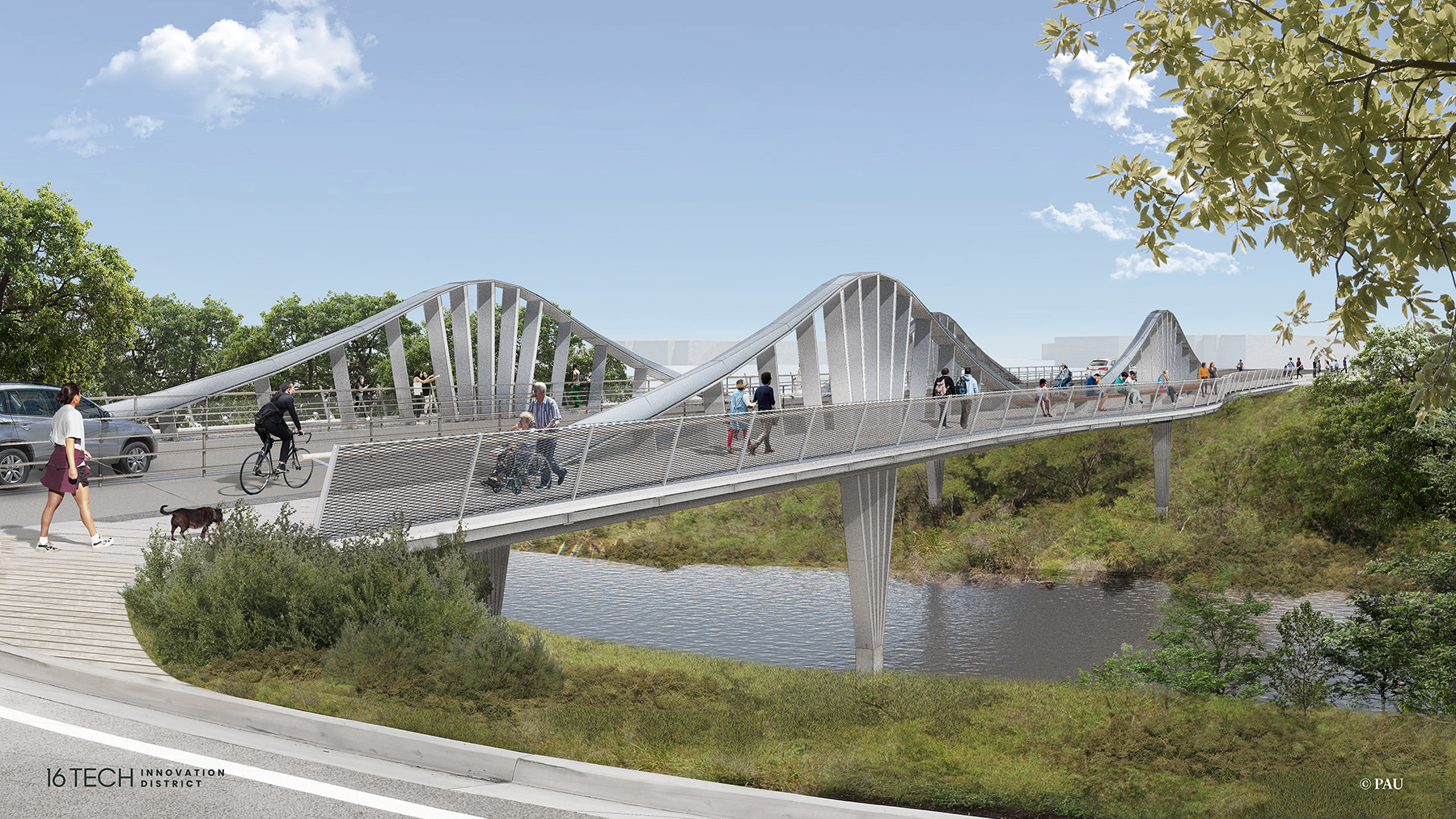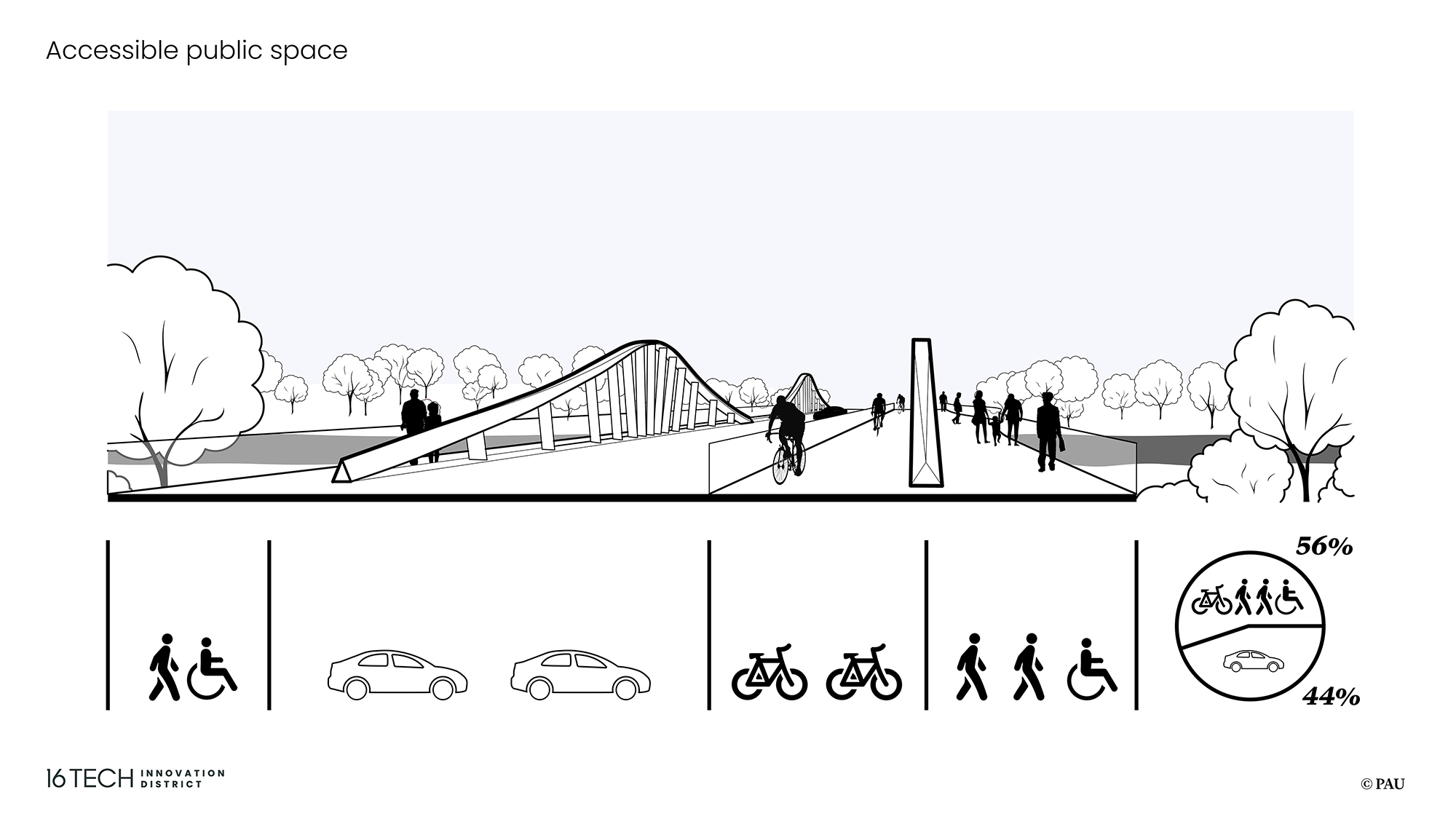By Robert L. Reid
Construction has begun on a unique bridge in Indianapolis that will be an unusual crossing, both in its structural design and in how it is used. It is a vehicular bridge with two lanes for motorized vehicles that prioritizes pedestrians and cyclists, reserving some 56% of its deck square footage for non-vehicular use.
The bridge will cross Fall Creek, a tributary of Indianapolis’ White River in the city’s downtown region. It will connect the 16 Tech Innovation District — a planned 50-acre campus of technology-focused industries, offices, laboratories, and residential and public spaces — located on the north side of Fall Creek with an existing area of hospitals and medical research facilities on the south side of the waterway, says Michael Stein, P.E., M.ASCE, a partner and managing director in the New York City office of schlaich bergermann partner, which is leading the multidisciplinary bridge design team.
Other members of the design team include Practice for Architecture and Urbanism, of New York City; Martha Schwartz Partners, also of New York City; Indianapolis-based engineering consulting firm Shrewsberry & Associates; CTL Engineering and Circle Design Group, both also of Indianapolis; Berlin-based Moniteurs Communication Design; and Indianapolis-based People for Urban Progress.
Although each member of the team had a specialty — for example, sbp was the structural engineer, PAU was the project architect, Shrewsberry was the civil engineer, and Martha Schwartz Partners was responsible for landscape architecture — all the firms worked together across disciplines to create a balanced design, Stein says. The goal was to find “beautiful solutions” to the project’s goals and challenges, he explains, not to “see things as just an engineering solution or just an architectural solution.”
Selecting steel ‘ribbons’ and fans
Framed in steel, the bridge will be oriented in a north-south direction and measure 342 ft long. The deck will measure approximately 75 ft wide — the width varying because of a bumped-out portion in the middle of the structure along its eastern side. This extended section will accommodate benches and provide a gathering space for people on the bridge, which is meant to serve as more than “just a crossing from point A to B but also as a destination,” Stein explains.
The eastern side of the bridge will feature a pedestrian lane and a cycling lane; the western side will have only a pedestrian lane.

Although the form of the bridge resembles a traditional suspension bridge, the 16 Tech bridge will feature a hybrid structural design that combines aspects of a suspension bridge and a truss structure, Stein says. For example, the design includes elements that could be seen as cables and hangers but which are, in fact, ribbonlike steel structures (instead of cables) and plate steel elements (instead of hangers). The ribbons on each side of the bridge will measure roughly 2 ft wide and act in tension. The trusslike hangers will be in tension at some locations, in compression at others.
Instead of the masts of a classical suspension bridge, the 16 Tech structure will feature a fanlike arrangement of boxed steel columns extending up from the concrete piers and working in compression. The ribbons, plate hangers, and fan columns will together create a wavelike form to the structure that is inspired by the natural setting of the site: The overall form of the bridge will rise and fall, mirroring the tree canopy on either side of the creek and the lower elevation of the creek itself in the center. The fan columns will create treelike shapes, while the undulating steel ribbons will resemble the natural profile of the creek.
Unlike the continuous steel cables of a suspension bridge, the pairs of steel ribbons on each side of the 16 Tech bridge will be anchored directly to the bridge deck, creating a gap through which cyclists on the eastern side of the structure can access the shared gathering space and views of the creek beyond.

The pedestrian lanes on each side of the bridge will cantilever approximately 11 ft from the deck. The cycling lane will measure approximately 12.5 ft wide, while the vehicular lanes will share a space roughly 25.5 ft wide.
The bridge will be supported at each end on concrete abutments, while the piers will be supported on concrete pedestals and piles that extend roughly 50 ft deep. The bridge deck will provide a clearance of approximately 22 ft above the creek during normal periods, although the bridge foundations potentially will be inundated during floods, Stein notes.
Talking to the community
The design of the bridge was strongly influenced by an extensive public outreach effort — led by People for Urban Progress — that spent six months gathering feedback from local residents, civic leaders, schools, and other stakeholders. Although the COVID-19 pandemic limited much of this outreach to virtual efforts, the community input helped determine the ultimate form and purpose of the new bridge.
The client — the 16 Tech Community Corp. — had originally been seeking a more traditional vehicular bridge, Stein says. But as the design team gathered information from the community about what residents and other stakeholders wanted from the project, “we decided, ‘Why just create another vehicular bridge with a small sidewalk?’” Instead, “we could actually create something which is also a ‘space’ for people, for programming events,” Stein says.
This process ultimately led to the design’s strong intermodal component, which features dedicated and protected lanes for pedestrians and cyclists, seating, and connections to a series of trails that are close to the bridge site. And more trails are planned, Stein adds.
The bridge is expected to open in late 2023 or early 2024.



